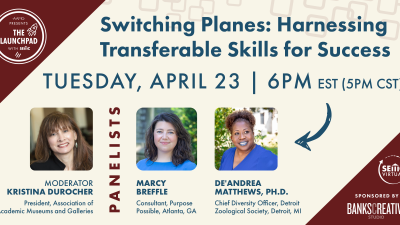This article originally appeared in the September/October 2010 issue of Museum magazine, a benefit of AAM membership.
About two years ago, an assistant director of a museum on a college campus called to share a quandary: Her department had produced 30 percent more programs and served 30 percent more people than the prior year … but she didn’t feel so great. She was overwhelmed with concern about what would be expected of her department now that the museum had achieved its goal of producing more programs and attracting more people. Could the department increase its output by another 10 percent or 15 percent the following year? How could her small staff possibly sustain that level of programming growth?
She knew that a continual focus on number of programs and attendees is unsustainable, and she wanted to stop doing more for the sake of doing more. The value of doing more, personally or organizationally, was not obvious. While she was busy producing 30 percent more programs, they weren’t necessarily deeply meaningful. Her director was happy with the increase in output, but she did not share his enthusiasm. Yet doing less was antithetical to her and her museum’s practice.
Museums’ measurements of achievement are often tangled up in building larger buildings, counting visitors and increasing programming. But to maximize their impact on the communities they serve, the fastest and most efficient path may be embracing the very un-American idea of scaling back.
Doing less feels scary, especially when other museums are still on the treadmill. All sorts of fears emerge when considering program reduction. Will the museum’s traditions be lost if programs are discontinued? What might fill the void? Will you receive a poor performance review? Sometimes such concerns prohibit organizations from taking a risk, pursuing a brilliant flicker of an idea or simply moving on when the time is right.
The less-is-more approach necessitates changing how museums plan, care for collections, select programs and exhibitions, and engage their communities. If numbers of digitized objects, visitors, programs or exhibitions are no longer accurate measures of success, then what is? Approaching work with different goals—for example, balancing quantity with quality, satisfaction with meaningfulness and national appeal with community relevance—may help all of us in the museum enterprise realize the true value of our institutions. Museum work isn’t only about how much or how many; it is also about providing the public with meaningful experiences that are personally relevant, significant and enduring.
There are several ways to explore the idea of doing less. For starters, only do work that is relevant to your museum’s community (and stop doing work that is not). A museum might need to re-examine its mission and community to determine which programs are not relevant and, likewise, which programs do not represent the intrinsic value and greatest strength of the museum. Do away with these in favor of programs that can make a difference now and in the long run. Exploring doing less through the lenses of relevance, public value and impact will shape more deliberate, intentional and purposeful decisions, thereby strengthening the museum as an organization.
Doing less may also require examining your target audience. In Baltimore, for example, the Sports Legends Museum at Camden Yards was having trouble attracting school groups because its focus doesn’t support the state’s curriculum. As staffers considered options moving forward, they decided to focus on the museum’s strength—its unique position as a place where men can gather and pay homage to their sports heroes. Such a bold decision does not mean the museum excludes women, children and teachers. In fact, a recent visitor study commissioned by the museum showed that women and children enjoy their experiences there. But the decision was important organizationally, with the museum redistributing resources to play to its strength. Everyone’s happy, and the museum doesn’t have to be something it’s not.
Similarly, when the Reynolda House Museum of American Art in Winston-Salem, N.C., was in the midst of annual institutional planning, staff vowed to be more intentional about its historic house programming. In examining their beloved tradition of hosting a holiday party for older adults, staff realized the program ultimately didn’t serve to make a meaningful connection between visitors and the museum. The program, held in accessible areas of the building for the convenience of attendees but away from the core of the institution’s American art and historic house collections, focused more on socializing than serving the museum’s mission. The staff decided that older adults were better served by other existing programs that were on mission. By no longer having to plan the holiday party, staff could redirect time, energy and resources into developing an entirely new interpretive program of guided candlelight tours that focus on winter traditions. They reached a new audience while appealing to their most loyal members.
Another key part of doing less is rethinking markers for success. For years, high visitation has been the brass ring, and it continues to excite staff and funders. Clearly, defining success in terms of quantity is easier than defining it in terms of quality, but attendance figures only mean that people came. They offer no indication of whether people had a meaningful experience. To help conceptualize different markers of success, staff could begin to articulate the museum’s distinctive characteristics, which can serve as a platform for defining the museum’s unique brand of quality and potential impact. Such a definition might help a museum measure another kind of success—quality of the visitor experience. Surveys of museum experiences often measure satisfaction. However, that may be a superficial measure in the context of what some museums aspire to achieve.
Oddly, doing less is a huge undertaking because of organizational ramifications and the potential for interference with tradition and status quo. But doing less can mean prioritizing and focusing work according to what an organization would like to achieve in terms of the public good. It also supports organizations saying “no” to resources or projects that prevent them from focusing on intended results.
Nearly all museums face the pressing reality that it is no longer possible to build larger museums and pile more work on at-capacity staff. If some museums are searching for a reason for doing less, consider the imperative for museums to clarify the impact they would like to achieve in their communities and documenting results that focus on quality, relevance and meaningfulness.








Comments